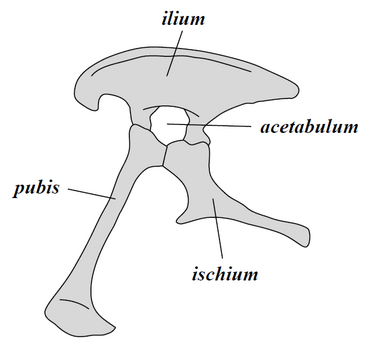Saurischia
| Saurischians | |||
|---|---|---|---|

| |||
| Montage of six different representatives of saurischian dinosaurs. 1st row (early saurischians): | |||
| Scientific classification | |||
| Domain: | Eukaryota | ||
| Kingdom: | Animalia | ||
| Phylum: | Chordata | ||
| Clade: | Dinosauria | ||
| Clade: | Saurischia Seeley , 1888
| ||
| Subgroups | |||
| |||
Saurischia (
Description
All
Saurischian dinosaurs are traditionally distinguished from
Classification
-
Saurischian pelvis structure (left side)
-
Tyrannosaurus pelvis (showing saurischian structure – left side)
-
Ornithischian pelvis structure (left side)
-
Edmontosaurus pelvis (showing ornithischian structure – left side)
In his paper naming the two groups, Seeley reviewed previous classification schemes put forth by other paleontologists to divide up the traditional order Dinosauria. He preferred one that had been put forward by Othniel Charles Marsh in 1878, which divided dinosaurs into four orders: Sauropoda, Theropoda, Ornithopoda, and Stegosauria (these names are still used today in much the same way to refer to suborders or clades within Saurischia and Ornithischia).[4]
Seeley, however, wanted to formulate a classification that would take into account a single primary difference between major dinosaurian groups based on a characteristic that also differentiated them from other reptiles. He found this in the configuration of the hip bones, and found that all four of Marsh's orders could be divided neatly into two major groups based on this feature. He placed the Stegosauria and Ornithopoda in the Ornithischia, and the Theropoda and Sauropoda in the Saurischia. Furthermore, Seeley used this major difference in the hip bones, along with many other noted differences between the two groups, to argue that "dinosaurs" were not a natural grouping at all, but rather two distinct orders that had arisen independently from more primitive archosaurs.[4] This concept that "dinosaur" was an outdated term for two distinct orders lasted many decades in the scientific and popular literature, and it was not until the 1960s that scientists began to again consider the possibility that saurischians and ornithischians were more closely related to each other than they were to other archosaurs.
Although his concept of a
One alternative hypothesis challenging Seeley's classification was proposed by
A 2017 study by Matthew Grant Baron, David B. Norman and Paul M. Barrett did not find support for a monophyletic Saurischia, according to its traditional definition. Instead, the group was found to be
| Müller & Garcia, 2020[17] | Novas et al., 2021[16] | ||||||||||||||||||||||||||||||||||||||||||||||||||||||
|---|---|---|---|---|---|---|---|---|---|---|---|---|---|---|---|---|---|---|---|---|---|---|---|---|---|---|---|---|---|---|---|---|---|---|---|---|---|---|---|---|---|---|---|---|---|---|---|---|---|---|---|---|---|---|---|
|
| ||||||||||||||||||||||||||||||||||||||||||||||||||||||
| Ornithoscelida hypothesis. Taxa traditionally classified as saurischians are highlighted in green. | |||||||||||||||||||||||||||||||||||||||||||||||||||||||
| Baron et al., 2017[12] | Cau, 2018[15] | ||||||||||||||||||||||||||||||||||||||||||||||||||||||
|
| ||||||||||||||||||||||||||||||||||||||||||||||||||||||
See also
References
- .
- PMID 23221875.
- ^ Oxford English Dictionary
- ^ S2CID 129792059.
- ^ Weishampel, D.B., Dodson, P., and Osmólska, H. (eds.). (2004). The Dinosauria. 2nd edition. University of California Press, Berkeley. 833 pp.
- ISBN 978-0-520-24209-8.
- PMID 19605396.
- ^ Weishampel, David B.; Dodson, Peter; Osmólska, Halszka (eds.) (2004). The Dinosauria, Second Edition. University of California Press., 861 pp.
- ^ Weishampel, D. B., Dodson, P., & Osmólska, H. (Eds.). (2007). The dinosauria. Univ of California Press.
- ISBN 0-14-010055-5.
- ^ Paul, G.S. (1988). Predatory Dinosaurs of the World, a Complete Illustrated Guide. New York: Simon & Schuster. 464 p.
- ^ S2CID 205254710.
- ^ "New study shakes the roots of the dinosaur family tree". 22 March 2017.
- ^ S2CID 4395996.
- ^ S2CID 44078918.
- ^ .
- S2CID 221298572.




